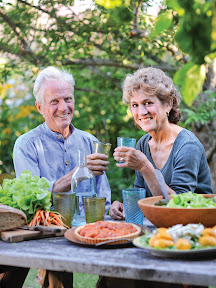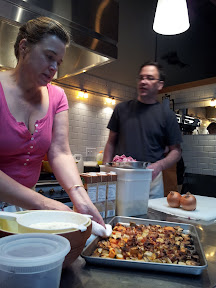Recently, I read and tried some recipes from The Four Season Farm Gardener’s Cookbook, From the Garden to the Table in 120 Recipes, authored by Barbara Damrosch and Eliot Coleman. Both have been operating the Four Season Farm for more than 20 years, and have been involved professionally in farming and teaching (both in authoring/publishing and hosting the series Gardening Naturally for the Learning Channel 1993-2003, among other credentials) for more than 35 years, with more than 75 years experience between both of them. You can read more about them in the New York Times profile from last year “The Land That Keeps Giving“.
This extensive background and experience of this couple really shows in the first half of the Four Season Farm Gardener’s Cookbook, which actually focuses on the Garden rather than food recipes- you can interpret it really as the first half being a Garden “Cook”book, and then the second half is the Table, with the promised 120 recipes and traditional cookbook.
I have been an urbanite whose gardening skills never have been explored more than growing a few of my favorite herbs of basil, dill, thyme, and Thai chili peppers, annually, so you can take this review as someone who is a total newbie to gardening, much less farming produce or anything beyond a windowsill box.
The book starts from the ground up- literally. The first chapter helps you identify what kind of soil you have, teaches you the difference between types of soil and how to improve your soil. The next chapters expound into how to think about and then decide on the size and layout of your garden, how to rotate different crops in your garden whether it be through a single year across seasons or across years. They then present six options of different kind of garden themes varying from one that is focused on producing lots of quick and satisfying results in the smallest space (The Salad Garden) to a theme of dependable crops (The Hard Times Garden) or one that you don’t have to reseed every year because they are perennial or produce seeds (The Self Reliant Garden).
There is one chapter that goes into depth on each possible crop (grouped by family as they require similar care in growing). One example is spinach, talking about the differences between the taste of spinach through the season, giving advice on how to grow it, then harvest it, then store it, and finally various options to cook it- and they expand this to include almost 70 kinds of produce you might be considering to grow. This is probably going to be the chapter that I thumb through over and over as I encounter beautiful items in the farmers market, as I look up the produce and read suggestions on ways to cook and enjoy it. Although this chapter is technically in the Garden portion of the book with its advice on growing and harvesting, the information on storing and cooking it are definitely Table territory.
Each of these chapters is written with the voice that has clearly done everything that has been written and can provide tips. The voice is aware of both the science of how to make decisions based on the reality of various situations and talking through all of the data and information you might use to analyze and decide or more efficiently garden (such as offering advice on tools or watering techniques or weed control)- aka extremely practical- while also catering to the art of garden as an emotionally fulfilling enterprise by detailing the rich colors and textures and beauty of nature and feeling of productivity and satisfaction of feeding plants and them feeding us in return. At one point, the authors note how as each crop is ready you feel like the year is full of “little festivals” of produce.
In this first half of the book, pictures and illustrations abound, enticing you with beautiful photos of produce you too can grow, or step by step of saving tomato seeds, or various map layouts of gardens or charts for crop rotations. So I was a little disappointed there were not more photos in the second half for the recipes. There are definitely some beautiful whole page layouts of some of the recipes, but many recipes have no photo, or at most a small photo of one of the ingredients of the recipe but not the dish itself. I am definitely a visual person, and the recipes I tried ended up being ones that had accompanying photos of the finished dish.
Her recipes are simple (she calls her style “prosperous peasant”), featuring the freshness of the ingredients, all from scratch and the majority of the components which can come fresh from the garden… or in my case, purchased from the farmers market and someone else’s garden. Since asparagus has been looking so beautiful at the market that was one of the first recipes I picked out to try.
Asparagus Goldenrod
This recipe comes from Barbara Damrosch and her mother, and is named for the grated egg yolk that appears like goldenrod pollen. I chose to use two types of bread (paesano and seedy grain), but did not remove the crusts (and whoever styled the dish for the food photo did not either!). As an homage to what Barbara and Eliot stand for, I used everything from the Portland farmers market or Local Choice Market except the butter and black pepper.
Ingredients (serves 4):
- 4 large eggs (mine are from Stiebrs Farm)
- 1 1/2 cups heavy cream (I used Garry’s Meadow Fresh Jersey whipping cream)
- 4 ounces (1 cup) of shredded Gruyere cheese (or, since I didn’t find a local Gruyere, I used a Gruyere-like cheese, Adams Alpine from Cascadia Creamery)
- 40 medium size fresh asparagus spears
- 4 large or 8 small slices of whole grain bread, crusts removed
- 2 tablespoons butter at room temperature
- freshly ground black pepper, to taste
Directions:
- Hard cook the eggs by placing the 4 eggs in a saucepan and adding enough water to cover the eggs. Bring the water to simmer over high heat, then immediately lower the heat and simmer for 10 minutes. Drain the hot water and fill the pan with cold water to cool the eggs for at least 5 minutes.
- Peel the eggs and remove the yolk carefully so they remain whole. They should be firm enough to now grate. Coarsely chop the egg whites and set aside for the sauce.
- Pour the cream into a medium size skillet and bring to slow simmer over medium heat, stir, stirring constantly, until it has thickened. Gradually add the grated cheese, stirring until it has melted and is smooth. Add the egg whites, and keep the sauce warm over low heat.
- Toast the bread and then butter (optional), putting them on the plate you plan to serve with.
- Trim the asparagus spears to about 5 inches in length, and steam until the asparagus is tender, 2-5 minutes. (Or, you can roast or grill the asparagus, whatever you’d like.) Distribute the asparagus spears over the pieces of toast, and then cover with the creamy sauce. Top with the grated egg yolk and some black pepper to taste, and serve immediately.
Barbara advises that depending on the season, you can easily substitute broccoli, cauliflower, green beans, leeks, garlic scapes, etc for the asparagus. For most of the recipes there is a “Try This Too” section that suggests some variations to try. She often also suggests other dishes to serve with to make a complete complementary meal. She suggested a salad and a dessert of fresh fruit for this, but I made her Green Gazpacho that celebrates the bounty of greens with green pepper, celery, scallions, jalapeno, parsley, cilantro, and chives. Barbara also notes that you might also try adding green tomatoes, or tomatillos, to this “chlorophyll explosion, refreshing and pungent”.
Green Gazpacho
Ingredients (serves 4 as a main course, 6-8 as an appetizer):
- 1 medium to large green bell pepper, stemmed, seeded, and cut into small chunks (approximately 1 1/2 cups)
- 1-2 (I used 2) green jalapeno peppers, stemmed, seeded, and chopped
- 1 medium size cucumber, peeled, seeded, and coarsely chopped (approximately 3/4-1 cup)
- 2 medium sized ribs celery, coarsely chopped (approximately 2/3 cup)
- 6 scallions (white and green parts), coarsely chopped (approximately 1 cup)
- 1 cup (packed) fresh flat-leaf parsley leaves
- 1/4 cup (packed) fresh cilantro leaves, or to taste
- 1 tablespoon agave syrup or 4 teaspoons raw sugar
- 2 tablespoons fresh lime juice
- 2 tablespoons fresh lemon juice
- salt and freshly ground pepper
- 1/4 cup extra-virgin olive oil (I happened to use blood orange olive oil)
- 1/2 cup sour cream (you can also substitute tofu here)
- 1 tablespoon very finely chipped fresh chives
Directions:
- Combine the bell and jalapeno peppers, cucumber, celery, and scallions and stir briefly. Put half the mixture into a food processor with 1 cup water and pulse until the mixture is just pureed, about 30 seconds. Return this to a large bowl (I used one that was 2.5 quarts).
- Repeat the above with the second half of prepped veggies + 1 cup water , but this time also adding the parsley, cilantro, agave syrup, lime and lemon juice, dash of salt and black pepper. Combine both purees in the large bowl, and add the olive oil and stir to mix. Taste and add salt or ground pepper as desired (this soup tastes best with enough salt to accent the flavors).
- Refrigerate if not serving right away. When serving, pour the gazpacho into individual bowls or glasses. Top each serving with 1 to 2 tablespoons of sour cream and a pinch of chives.
Barbara Damrosch will be at POWELL’S BOOKS AT CEDARS HILL CROSSING (3415 SW Cedar Hills Blvd. Beaverton) on THURSDAY, MAY 30TH at 7pm to say hi and find out more about The Four Seasons Farm Gardener’s Cookbook (and get signed copies) she co-authored (she helped write the first half, and did most of the second half), or get advice about gardening. Barbara also authors a weekly column A Cook’s Garden in the Washington Post, seriously she is amazing.
Disclosure: This book was provided by Workman Publishing for me to review. The views and opinions expressed in this blog are entirely my own, and I will always provide my honest opinion and assessment of all products and experiences regardless of whether they were complimentary or not.












